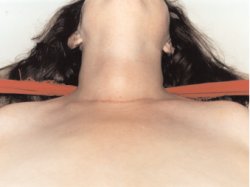Helen James explores the landscape of contemporary photography, and the challenges that face those who inhabit it.
Photography has a special place in the portfolio of visual art. Since it was introduced to an art public as a medium worthy of their viewing attention, it has developed into a sophisticated artform that is the favourite choice of many artists wishing to capitalise on its unique characteristics and special appeal.
A recurring issue in photography is its mass appeal as a mode of immediate image creation. Often, and perhaps increasingly, referred to as the democratic artform, photography faces the unusual conundrum of its technological accessibility and wide appeal undermining its potential art status. Contemporary photography has a particularly unclear boundary between pictures that have commercial viability and are produced for commercial reasons, and pictures that are produced to directly appeal to the art market. The division between art and commerce is perhaps not as clear as it once was, when categories seemed to be able to contain advertising, fashion or reportage photographs in context. The communicative style of contemporary photographs is increasingly sophisticated and as likely to refer to photographys own historical portfolio of styles as it is to a task in hand, such as selling products, narrating experiences or describing places.
Current challenges
In contemporary photography, style, concept, format and application have been stirred up to offer a smorgasbord of visual opportunities for the viewer of photographic images and a history of opportunities for the image-maker. For example, vernacular photography is now an acceptable visual flavour with an identifiable style, concept and application whose workaday, ordinary and familiar visual language is now utilised beyond the vernacular purpose. Such branches of photography have moved centre stage, validated and vindicated by the cultural community, and sit easily next to the slick communicative powers of advertising as much as become fodder for it. The photographer has truly become artist as much as the artist has become photographer.
Contemporary practitioners face an interesting and challenging proposition when they engage with the medium today. They, and the roll-call of photograph managers (editors, curators, critics), face a huge challenge in using photographs to share a comment about the world. Contemporary photographers find themselves with the complex task of challenging the medium and the nature of photographic representation itself to encourage a viewing public to engage with their thoughts, ideas and observations. Certainly for the gallery context, they face the challenge of interrogating, teasing and manipulating existing vocabularies to enable them to offer new ways of communicating with photography.
Photography has always been present in the art world, offering, from its early history, a range of opportunities to view photographs in public places such as the art gallery or museum: not perhaps the first, or even the natural, home of the photograph but certainly the preferred home for the art of photography and an appealing location for the artistic photographic practitioner to aim for.


Public recognition
Each year the National Portrait Gallery in London offers a photography prize for the photographic portrait. This particular awards system encourages approximately 6,000 entries per year to materialise from the image ether. What is interesting about this award is not the mechanics of the hallowed judgements of a select few, but the opportunity to view a snapshot of visual activity from the photographic world pictures of people, taken by all sorts of photographers for all sorts of reasons. Three photographers whose work has appeared in the back catalogue of these awards are Marysa Dowling, Adri Berger and Trish Morrissey. These three photographers are representative and interesting in relation to the way they manage their careers and where we, a viewing public, find their work.
Marysa Dowling (www.marysadowling.co.uk) is a photographic artist who has developed a successful career in educational gallery and community work, which she marries with her intelligent collaborative personal practice. Her art is concerned with the history and culture of photographic representation and explores the social, forensic and psychological qualities of the photograph to enable her to comment on specific personal, familial and societal issues.
Trish Morrisseys work (http://www.trishmorrissey.com) has been widely circulated on the gallery circuit. It is serial with one image building on the previous one to create a coherent and useful visual comment. Her unique and identifiable style offers a valuable invitation to discuss the moment and the gesture in photographic time and space.
Adri Berger (http://www.adriberger.com) is a highly successful commercial photographer who can manipulate his style according to the brief in hand. His successful career enables him to carve a space in his calendar to experiment with the creative potential of a long-term personal photographic project that looks at the meaning of time in different world cultures.
All these photographers have a different relationship to the art and commercial sections of the photographic world. But they are united in their desire to experiment with the nature of photographic communication and develop a rich body of work that can contribute to the global image community a task only made possible by increasing the visibility of themselves and their work, hence the appeal of prizes such as that at the National Portrait Gallery.
The name game
Getting bogged down with terminology around how image-makers choose to describe themselves and their practice (who is an artist and who is a photographer) is an interesting exercise but not particularly useful here. What is more important is to attempt to define the landscape that they work within, which brings us to the gallery the space somewhere in the middle of education and commerce that allows the viewer an opportunity to look. The gallery is the arena that needs to tempt and encourage an open-minded audience to be annoyed, inspired or simply persuaded to think again about the unique characteristics of the photographic image. In the UK we have an awkward and disjointed photographic landscape whose players operate across it in very different ways. The terrain includes smooth, featureless plains that are open for the artist to roam freely, spiralling towers of commerce that control and direct the corporate commission, and the temporary, shifting homes of the special project that sometimes find a way to publication or exhibition.
The difficulty for those wishing to engage with photography is finding a guide to the region that is informative to viewers, practitioners and critics alike. How and where we find photography is important so that the issues relating to its special democracy dont get lost or neglected in the wider pool of visual art.

Helen James is a freelance writer, researcher and educator on photography, and an associate lecturer at London South Bank University.
e: helen@helenjames.demon.co.uk. Currently working with The Photographers Gallery, she has also worked as an education manager at the National Portrait Gallery, Photoworks (Brighton), University of the Arts, the Association of Photographers and Liverpool's Open Eye Gallery.



